Home | Front Page | Index | Blog | New | Contact | Site Map
Lake Peten Itza
Tikal
Coban
Guatemala City
Lake Atitlan
Markets
Antigua
Rio Dulce
Esquipulas
Mundo Maya
Foto Show

Central America
Route Maps
Belize
Honduras
Nicaragua
Costa Rica
Panama
Mexico 2003-04:
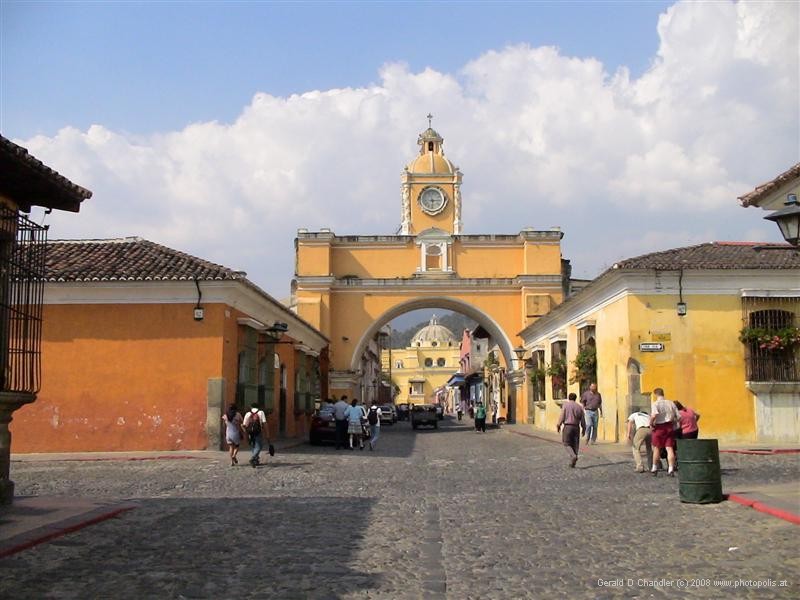
Antigua Guatemala, Guatemala |
If it's confusing to have a country and its capital with the same name, imagine how much more confusing to add the former capital to the mix! Antigua, meaning old of course in Spanish, is short for Antigua Guatemala or in other words the former Guatemala City.
Antigua Guatemala is only 15 miles as the crow flies southwest of downtown Guatemala City but about twice as far by road. For about 250 years Antigua was the Spanish colonial capital of Central America, which then included Chiapas (in Mexico now) but not Panama. As capital, many official buildings and two dozen or more large church/monastery and church/convent compounds were built. The latter often occupied full blocks, about 800 ft x 1000 ft (250 x 300 m). Other of these blocks were mostly filled more modestly, with courtyard houses, some quite large, but typically like our hotel: 70 ft x 100 ft, with family rooms and so forth around the courtyard.

|
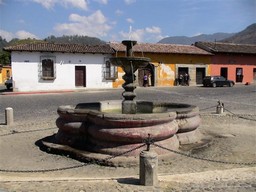
|
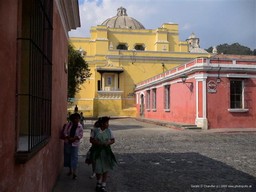
|
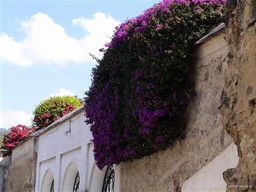
|
The Streets of Antigua
On the south and west there are three volcanos. Volcano Agua, very prominent at 12,388 ft when looking south from the center of town, is the only one of the three that is active. They and many others farther away arose because the whole of southern Guatemala sits above three rapidly moving and intersecting tectonic plates. Their motion gives rise to frequent earthquakes.
In 1773 normal life literally came to a crashing end with a giant earthquake which, unlike earlier earthquakes, convinced the Spanish authorities that what was God's will should be theirs: move to a safer place. They chose modern Guatemala city and passed a law that everyone should move. As in today's Guatemala, where (according to local newspapers) corruption seems to be rife not everybody obeyed the law, so to make the new Guatemala City viable the old city was ordered destroyed. Luckily for today's history lovers many residents remained disobedient and much of the city was preserved, even if damaged. As the years went on reconstruction and repair was done, but there was just not the population to support a complete rejuvenation.
Jump ahead to the late 20th century. Infrastructure and tourism grew apace. More and more of the town's core began to be restored to its glorious colonial past. Many of the old courtyard houses became hotels and restaurants and shops, all of them lovely on the inside and quaint on the outside, with their giant wooden doors and pastel walls running the lengths of the cobblestone streets. What once was a broken slum, to judge by some old photos, became a pristine seductress, with the houses all low-rise and painted in ochres and yellows and pinks. A few of the major churches have been completely restored, or at least are in use, and are enjoyable jewels. In addition, almost everywhere you turn there is another romantic ruined church or monastery, a gothic novel brought to life, but almost better than life.

|
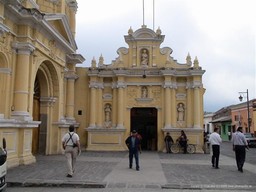
|
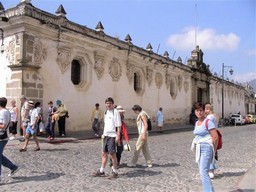
|
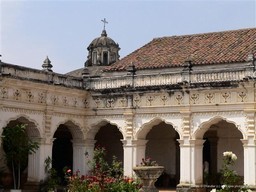
|
The Public Buildings of Antigua
We arrived on a Tuesday. Our first choice hotel was booked solid from Wednesday on, so we cruised the streets looking. Shortly we found ourselves in front of the El Carmen hotel, where we got a bargain on the room as it was empty or almost empty. We were told we couldn't keep the room past Thursday because of the coming weekend crush (but later they let us stay Friday too) -- Antigua is a popular weekend spot for the better off of Guatemala City. The weekend after our arrival, being in Lent, was to be a double draw: there would be a standard Lent procession in friar's robes and also celebration of the 401st anniversary of the founding of the city.
We had peace and quiet our first two mornings in the El Carmen but the third morning was spoiled by a motorcycle group having their early morning conversations in the courtyard below our room. That night and the next morning meals were served to a small but noisy group of women in the courtyard.

|
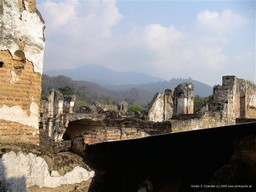
|
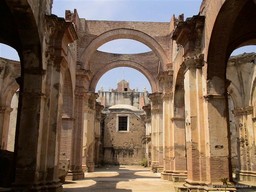
|

|
The Ruins of Antigua
Most of our time in the town was spent walking about and breathing in the atmosphere. At this time of year the climate is superb: cool nights, warm in the middle of the day with deliciously cool breezes morning and afternoon. We toured the ruins of the Merced and San Francisco monasteries and of the old cathedral. In the latter somehow two of the crypts survived and we went down into them. We wondered if we would suddenly have bricks tumbling down on our head if the ground shook.
On our first day in town we saw the Museo de Santiago, containing old weapons, canons and other artifacts from colonial times, and housed in the former Government House. It was nice but we wouldn't have missed much if we had skipped it. So we skiipped the nearby Museo del Libro Antiguo.
On our last day we went to the Museo Casa del Tejido (House of Weaving and Textile Museum), a slightly misnamed place. After we entered we found that we would get a guided tour even though the entry price was only Q10 ($1.25), because, as we learned, the "museum's" true purpose is to support indigenous people by selling their handicrafts. Our guide took us past a series of life-size mannequins dressed in the costumes of places we now recognized: Solola, Chichicastenango, etc. At the end she gave us a chance to buy from rack after rack of lovely goods. Being overstocked with Thai and Lao hand-woven cloth, Jan reluctantly declined, as she has been doing throughout the region.
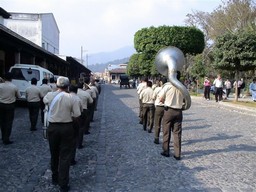
|
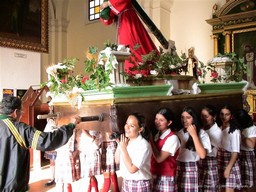
|
The Parades of Antigua
In answer to our questions our young guide told us that she had made by hand the costume she was wearing; it took about nine months working about six hours a day. She was seventeen and took this job because she could not afford to continue at school. That would have cost her about Q15 a month, much less than we typically spent on lunch. Our two tickets could have kept her in school for a month; one night's lodging at the prices we pay would pay for a year.
Antigua is the only place we expected to find American retirees but didn't, although we're sure they are there. We make this guess because it is perhaps the first place we've found that we might consider retiring to ourselves. It is an island of beauty and prosperity. We would have liked to linger in Antigua but the weekend crush of visitors forced us out of the El Carmen. Antigua is the nicest place we have been in a long time. It is not to be missed.